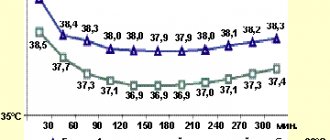Introduction
The question of first complementary feeding arises before every mother several months after the birth of the baby. It often causes a lot of controversy and disagreement. How to introduce complementary foods correctly? When is the best time to start this process and what to use first? How to make sure your baby is ready? When to introduce complementary foods during artificial feeding? Let's try to figure out what the World Health Organization (WHO) and the Russian Union of Pediatricians advise on this matter, and how to competently start complementary feeding in order to help the growing orgasm get acquainted with the new stage of its life without negative consequences.
What is the introduction of complementary foods?
In general, the process involves feeding infants foods that are needed by that age to supplement breast milk or formula. It is divided into two groups:
- Transition food. These are products that are specifically designed for the physiological needs of infants;
- Food from the family table. This includes foods that are consumed by all family members;
Gradually, children are accustomed to eating homemade food until it completely replaces breast milk/formula. On average, a healthy child by the age of 1 year is physically able to completely switch to food from the seed table. The child does not have the physiological maturity to immediately master such food, so to bridge this gap he needs special adaptive food (food of the transition period).
First complementary foods during breastfeeding and artificial feeding. When to start?
The question that worries everyone is when to introduce complementary foods during breastfeeding and bottle feeding?
According to the recommendations given by WHO, the first complementary feeding, for both types of nutrition, should begin if the child is six months old, in some cases it can be started a little earlier, but not earlier than 4 months. By this time, the baby’s body will be sufficiently formed and strengthened to begin mastering new food. The Union of Pediatricians of Russia advises starting to get acquainted with food between 4 and 6 months, but do not forget to take into account the individual characteristics of the baby.
Before 4 months, the baby’s body does not have the digestive enzymes and sufficient immunity necessary for a correct reaction to previously unknown food, which means the risk of allergic reactions increases. In addition, by about 5-6 months the baby gains the ability to swallow food rather than push it out of the mouth, which is associated with the development of its nervous system.
If you are wondering whether you need and how to properly introduce complementary foods at 4 months, it is better to seek recommendations from your pediatrician.
If you introduce complementary foods too late, a situation of micronutrient deficiency may arise in the child’s body, since breastfeeding and artificial feeding no longer meet all the necessary needs of the growing body.
What products should not be used when introducing complementary foods?
, foods that can provoke severe allergic reactions pose a danger Most often, allergies in childhood are caused by:
- chicken eggs;
- whole cow's milk;
- soy products;
- peanut;
- wheat;
- fish;
- seafood [9].
But some products from this list are allowed even in infancy - eggs, fish and cow's milk. They are introduced into the diet with extreme caution:
- egg whites are not used - only the yolk, starting from 7 months;
- cow's milk - closely monitoring the general condition of the baby;
- fish puree - no earlier than 8 months of age.
In the first year of life the following is also prohibited:
- sweets, confectionery and baked goods;
- food with a high salt content (pickles, nuts, salted straws, crackers);
- fruits and berries in red and orange shades;
- foods that cause increased gas formation in the intestines - grapes, legumes, yeast baked goods, rye bread;
- mushrooms;
- honey;
- fatty meat - pork, lamb, duck and goose.
These products are dangerous not only due to allergic reactions. They are poorly digested and not absorbed by the child’s body, overloading the liver and kidneys. Bloating, bowel disorders and rashes are not a complete list of problems that can be caused by improper baby food. When building a baby’s diet, be guided by the recommendations of pediatricians and individual characteristics. Periods of seasonal infections, underweight, chronic constipation or diarrhea will be good reasons for adjusting the complementary feeding regimen from Table No. 1.
References: 1. Agostoni C, Decsi T, Fewtrell M, Goulet O, Kolacek S, Koletzko B, Michaelsen KF, Moreno L, Puntis J, Rigo J, Shamir R, Szajewska H, Turck D, van Goudoever J. Complementary feeding: commentary ESPGHAN Nutrition Committee. 2008; 46(1):99–110. 703 2.Michaelsen KF, Weaver L, Branca F, Robertson A. Feeding and nutrition of infants and young children. WHO regional publications. European series. 2003;87:368. 3. Section on Breastfeeding of the American Academy of Pediatrics. Breastfeeding and drinking breast milk. Pediatrics. 2005; 115:496–506. 4. National program to optimize the feeding of children in the first year of life in the Russian Federation. M.: Union of Pediatricians of Russia. 2011. 68 p. 5. Skvortsova V.A., Borovik T.E., Netrebenko O.K., Lukoyanova O.L., Zvonkova N.G., Mayansky N.A., Kopyltsova E.A., Melnichuk O.S. Scientific substantiation of the scheme for introducing complementary feeding set out in the “National Program for Optimizing Feeding of Children of the First Year of Life in the Russian Federation.” Part 1. Issues of modern pediatrics. 2011;10(6):128–136. 6. Sorvacheva T.N., Gordeeva E.A., Anikieva E.N. Lure. From regulations to an individual approach. Issues of modern pediatrics. 2011;10(5):45–48. 7. Makarova S.G., Vishneva E.A., Alekseeva A.A. Recommendations for introducing complementary foods to patients with food allergies and children at risk: what and when? Pediatric pharmacology. 2014;11(5):45–51. 8. Frederiksen B, Kroehl M, Lamb MM, Seifert J, Barriga K, Eisenbarth GS, Rewers M, Norris JM. Infant susceptibility to developing type 1 diabetes mellitus: The Autoimmune Diabetes in the Young Study (DAISY). JAMA Pediatr. 2013;167(9):808–815. 9. Baranov A. A., Namazova-Baranova L. S., Borovik T. E., Makarova S. G., Yatsyk G. V., Skvortsova V. A., Turti T. V., Vishneva E. A. ., Alekseeva A. A., Roslavtseva E. A., Zvonkova N. G., Lukoyanova O. L., Snovskaya M. A. Food allergy. Ed. A. A. Baranova, L. S. Namazova-Baranova, T. E. Borovik, S. G. Makarova. Ser. "Childhood diseases from A to Z." Moscow. 2013. 10. Muraro A., Werfel T., Hoffmann-Sommergruber K., Roberts G., Beyer K., Bindslev-Jensen C., Cardona V., Dubois A., duToit G., Eigenmann P., Fernandez Rivas M., Halken S., Hickstein L., Host A., Knol E., Lack G., Marchisotto MJ, Niggemann B., Nwaru BI, Papadopoulos NG, Poulsen LK, Santos AF, Skypala I., Schoepfer A ., Van Ree R., Venter C., Worm M., Vlieg-Boerstra B., Panesar S., de Silva D., Soares-Weiser K., Sheikh A., Ballmer-Weber BK, Nilsson C., de Jong NW, Akdis CA EAACI Food allergy and anaphylaxis. Guidelines. Diagnosis and treatment of food allergies. Allergy. 2014; 69:1008–1025. 11. Turti T.V., Makarova S.G., Zimina E.P. Prevention of allergies in children during the period of introducing complementary foods (to help the practitioner). Question let's modernize Pediatrics 2014; 13(6):512–556.
Rules for successful complementary feeding
Before introducing your baby to new foods, you need to understand some basic nuances of how to properly introduce complementary foods to your baby:
- Observe your baby's behavior, assessing his level of readiness. Does he try to sit? Has he developed the ability to swallow food rather than push it out, and has he developed an interest in food at the table?
- You should not offer previously unfamiliar products in the evening, because... in this case, you can miss possible negative reactions of the body and not react to them;
- Products that have not previously been introduced are given strictly one at a time. There is no need to introduce five new products in one day;
- We begin to include all new dishes with 0.5 tsp/l, and increase their volume throughout the week;
- Avoid adding previously unknown foods to your diet during periods of illness, vaccination, and in cases of sudden change of environment.
What to give a seven month old baby?
By this time, new foods are introduced into the diet. The baby has already grown up enough, and his feeding schedule should be similar to that of an older child. In simple words, he should have three main meals and two additional ones: breakfast, second breakfast, lunch, afternoon snack and dinner. However, there is no need to demand too much from a seven-month-old baby. He still wakes up at night, since this is a physiological norm for him.
At this age, children are given a taste of the yolk of a chicken egg. To begin with, they give 1⁄4 pieces. If a child refuses to try an unfamiliar product, it is mixed with porridge or vegetable puree. When including yolk in the menu, you must carefully monitor the child’s reaction.
In addition to the yolk, at the age of 7 months you can start giving your babies special baby cookies. No more than 1-2 pieces per day. It is important to understand that cookies are not a complete food. This is a dessert that is served as an afternoon snack or after a full lunch.
If new products do not arouse your child’s interest, try mixing them with familiar and tried ones. For one meal, the baby should eat about 150 grams of porridge or puree. However, everything is individual here; you need to look at the physiological characteristics and needs of your child.
Complementary feeding calendar
How to start complementary feeding correctly? We present an indicative calendar for the introduction of complementary foods for children from 4-6 to 12 months. Its main points are based on the recommendations of the World Health Organization and the Union of Pediatricians of Russia.
Diet for a 4-5 month old baby
For those who are thinking about introducing their baby to new foods at 4 months, we advise you to consult your pediatrician. He will see if there is a need for this and give recommendations on where and how best to start.
How to properly introduce complementary foods at 5 months?
Complementary feeding at this age is best introduced with vegetable puree or porridge. These products are the easiest for a child's body to digest.
For example, you can start complementary feeding with vegetables with 0.5 tsp (3g) of zucchini puree. During the first week, you need to limit yourself to only this product for breakfast, increasing the volume every day and bringing it to 27 spoons (166 grams). When the volume of puree is more than 100 g. It is recommended to add 1 tsp of vegetable oil to it. We finish breakfast with breast milk or formula until completely saturated.
Next week we will begin introducing a new vegetable – cauliflower. We prepare two types of puree for breakfast - introduced zucchini and new cauliflower puree. First we offer 3 grams. new puree, and then add the previously introduced 166 grams. puree. Over the course of one week, introduce cauliflower entirely, replacing zucchini with it.
For the third week, broccoli puree is good. We also introduce 3 g. and feed the rest with the already familiar puree to a whole portion.
After your baby has successfully mastered vegetable purees, when you have already increased their volume to a whole serving, you can try making porridge for breakfast. For example, we introduce buckwheat for breakfast. We proceed in the same way, increasing the volume from 3 grams. up to 166g. per week with the addition of 1 tsp/l butter with 100 g. porridge. We eat the previously introduced vegetables in full for lunch.
How to properly introduce complementary foods at 6 months?
If by this period you have already introduced a number of products, then continue to use them, adding new ones to them.
Then you can add, for example, rice or buckwheat porridge, proceed in the same way as with puree. We take 0.5 spoons of new porridge, and feed the rest with the already introduced porridge with butter. We eat the previously introduced vegetables for lunch.
For lunch, you should offer new purees, such as pumpkin. At the same time, we leave breakfast unchanged, without introducing new types of cereals.
A wide selection of fruit and vegetable purees for children from 6 months, as well as a variety of cereals for children from 4 months, produced with an adapted milk formula based on goat's milk, is presented on our website. Due to the presence of prebiotics and a special DigestX complex, the risk of colic and constipation is reduced, the immune system is strengthened, energy metabolism and digestion in general are improved. And every baby likes the delicate creamy taste of Kabrita cereals and purees!
Diet of a 7 month old baby
Next, we include fruit (apple and pear) and meat purees (turkey and rabbit) in the child’s diet. We introduce fruit puree for breakfast, also starting from 0.5 tsp/l and increasing the volume to 10 tsp/l, and supplement with the previously introduced porridge.
We include rabbit meat puree after the applesauce has been completely introduced. We offer for breakfast starting from 0.5 tsp/l and slowly increasing to 8 tsp/l. We supplement the food with the previously introduced porridge.
When thinking about your baby’s nutrition, try to organize nutritious breakfasts and lunches for him, teaching him to eat at a certain time.
Diet for an 8 month old baby
Most likely, your baby will make his first attempts at feeding on his own around the age of eight months. Support your baby in this endeavor and give him small pieces of vegetables and fruits that he can hold in his hand on his own.
Also, this time is suitable for introducing fish, cottage cheese (no more than 50 g/day) and children’s kefir/biolact (up to 200 g/day) into the diet. For fish, give preference to cod, pollock, sea bass, salmon, pike perch or carp, and give it no more than twice a week.
You can start combining products with each other, adding, for example, berries to porridge or cottage cheese. We also begin to give a little bit at a time, gradually increasing the amount.
Diet of a child 9-12 months
By nine months, most of the foods needed now have most likely already been introduced, so continue to increase the baby’s diet, move away from the puree type and switch to a finely and coarsely ground consistency. As the year approaches, it’s great to start including fresh herbs from the garden in your diet.
At about one year of age, most children tend to pick up cutlery while sitting at the table independently and drink from a mug. Don’t disturb your child, but on the contrary, encourage his aspirations, even if it doesn’t work out well yet, because this is a complex skill that needs to be developed gradually, and an excellent workout for the brain.
WHO recommends continuing breastfeeding and formula feeding after the introduction of complementary foods.
Fish day and first feeding
Fish is a very healthy product, rich in vitamins and antioxidants, but it must also be administered carefully. I recommend starting to introduce the first fish complementary foods at approximately 7–8 months. It is better to start with species such as cod, hake, and haddock. The rules are the same: for the first three days, “grammatically”, then slowly increase. If there are no problems in a week or two, you can try delicacies such as tuna or salmon, canned children’s food, of course, if you can find it. It is better not to mess with trout and salmon in the first year of life, these fish are all stuffed with dyes and antibiotics.
No matter how hard I tried, the article about the first complementary foods turned out to be long. Thank you for reading to the end, I hope it will be useful. If you have questions about the introduction of complementary foods, you can write your requests on our website in the section asking a specialist. A short answer can be obtained on the Internet, but in order to make a diagnosis and give a detailed consultation, of course, you need to come to an in-person appointment with a pediatrician and children's allergist.
Porridge or puree? Where is the best place to start?
There is no exact answer to this question. You have the right to start as you wish, taking into account a number of recommendations:
- When introducing complementary foods, it is easier for babies to get used to vegetables first, since they are the most bland product;
- It is recommended to start with vegetable purees for children who have problems with excess weight, with anemia, rickets, frequent constipation and colic;
- Porridge is considered a heavier food for a baby’s developing digestive system;
- Pediatricians advise children who are underweight and predisposed to allergies to start introducing cereal into their diet;
Transitional power
The next most important period in a child’s life is the introduction of complementary foods as a stage of gradual preparation for completely independent nutrition. This is a very important moment in the life of a family. Many parents wonder whether there are any possible health consequences with earlier or, conversely, later introduction of certain foods into the diet, and at what months it would be most optimal to start complementary feeding. The next group of questions is related to the choice of food group to start with and the correct sequence of administration. These aspects not only concern parents, but are also the subject of numerous scientific studies, based on which recommendations are formed. Taking into account modern knowledge, it can be argued that the timing, quality and quantity of food introduced into a child’s diet cannot be arbitrary values, but they also do not have a uniform scheme for everyone. They are largely determined by the individual characteristics of the baby, and must correspond to the modern general nutritional strategy for a child in the first year of life.
Water for an infant
WHO advises not to give water to children who are only breastfed, because milk is fully capable of providing the baby with all the necessary elements for growth and development. An exception, of course, is made during hot weather and illness, then we give water little by little and carefully, from a spoon. Children who are fed with adapted milk formulas need water, but only at their own request; there is no need to force them to drink. Once you have decided to start giving complementary foods, it’s time to establish your child’s drinking regime. With the addition of new dishes to the diet, water is important for a small body for better absorption and comfortable digestion.
Mom's milk
Breast milk is the ideal food for babies in the first months of life. Nature itself regulates the composition and required amount of milk produced by the mother, adapting to the needs of the child. So, immediately after childbirth, when the baby is just adapting to the changed living conditions, learning to get food, and the mother is learning to feed, she produces colostrum. This is a highly nutritious product that, in small quantities, provides satiety and plays a protective role. As the baby grows, milk becomes more abundant and its quality composition changes, but throughout the first year of life it is the main food product for the child. Therefore, it is very important that the diet of a nursing mother is complete and satisfies not only the need for basic nutrients, but is also rich in vitamins and minerals.
IMPORTANT! It must be remembered that breast milk contains biologically active molecules that control the growth and development of the child, as well as protective proteins - immunoglobulins, which ensure the baby’s immunity to viral and bacterial infections. Modern scientific and production technologies make it possible to create adapted formulas that are as close as possible to human milk, but today it is impossible to artificially reproduce this unique product.
Every mother should strive to establish and maintain breastfeeding; by doing this, she determines the best path for her baby’s development, provides mental and emotional comfort, and also forms a health reserve for the future.
Developing taste
It is very important not just to feed the child, but to teach him to eat with pleasure. The Kabrita baby food manufacturer can help you in this matter (. They have a large assortment of high-quality purees and cereals for first feeding, and in addition, healthy products for further nutrition and shaping the taste of children.
The main thing you must achieve is the child’s interest in the food on your table, his desire to pick it up and try it on his own.
What should I do for this?
- It’s good when the baby eats at the same table with adults. Everyone eats, thereby setting an example for him;
- There is no need to force your baby to eat or lure him with cartoons and toys;
- The amount of food should increase only at the request of the baby;
- Try a variety of dishes with your child;
- Do not serve sugary drinks or offer cookies/waffles/candies before meals;
- Teach your baby to eat carefully and with cutlery;
- Do not keep your child at the table if he no longer wants to eat or indulges in food.
Teach your baby to feel food, its texture, shape and smells. Talk about the tastes of food; ask older children to talk about what they feel (sour, salty, sweet, bitter, crunchy, etc.).
Development of chewing skills
Many parents deliberately feed their children pureed and liquid food for a long time in order to reduce the risks of protests against pieces, scandals due to reluctance to eat on their own and fear that the baby will choke.
By 9-10 months, the child should definitely start eating more dense and solid foods. This skill is closely related to speech development, dental health and bite formation. And of course, by doing so you will open your child to the wonderful world of delicious food.
Start offering foods that won't break down or get stuck in your throat: banana, avocado, boiled potato, baked apple, etc. You will be surprised, but the child will master this skill very quickly if you do not interfere with it!
The main mistakes of parents
According to statistics, only 45% of young parents adhere to doctors’ recommendations regarding the introduction of complementary foods. As a result of the wrong approach, children do not receive enough nutrients and microelements necessary for full growth and development. Let's look at the main mistakes using specific examples.
- Premature introduction of new products. The introduction of complementary foods before 3 months increases the risk of developing excess weight, gastrointestinal diseases, and may also serve as a prerequisite for the development of diabetes.
- Postponing complementary feeding until later. Lack of complementary feeding after six months leads to a lack of microelements and nutrients. There may be developmental delays or problems with eating behavior in the future.
- Introducing too large portions. Because of this, the child may refuse breast milk or formula, which until a certain time are his main source of nutrients. In addition, the fragile gastrointestinal tract is simply not ready for such stress.
- Feeding only pureed foods for too long. After six months, the baby develops a chewing reflex. At this age, food can be cut into pieces. Refusal of solid foods can lead to digestive problems, as well as difficulties with speech development.
- Make the child finish the entire portion. If the baby shows with all his appearance that he is full, feeding should be stopped. Otherwise, overeating may cause vomiting or stomach upset.
- Transfer the baby to general nutrition at 10-12 months. “Adult” dishes contain a large amount of fats and other elements that a child’s stomach is not able to completely digest.
- Give harmful foods. Almost 80% of parents already in the first year of a child’s life give him a taste of chocolate, cookies, sausage, dumplings and other dangerous foods. These products are dangerous not only for babies, but also for adults. They also lead to disruption of healthy eating habits.
Instilling healthy eating habits
Do not forget that children follow the example of their parents in everything. If you are used to eating junk food, then don’t expect anything different from your child. If every day he sees a picture of how his parents eat cookies, candies and sausages instead of cereals and vegetables, naturally, the baby will also take a closer look at these products and want to try exactly what his adults eat.
If you want to raise a healthy child, then first of all you need to change your habits and try to set him a positive personal example.
What should you not give to infants?
There are a number of foods that children under one year old should completely avoid eating. Such products include primarily sugar, salt, foods that can be choked on - nuts, grapes, raw carrots, raisins, peas, etc., soda, juices, fruit drinks, compotes, whole milk, honey and semolina porridge. These products will bring absolutely no benefit to the child’s body, but can, on the contrary, cause harm.
We tried to fully cover the question of when it is possible to introduce complementary foods to a child and how to make this process so that as a result the child receives good health, pleasure from the learning process and correct eating behavior.
Let your children be healthy and happy!
- Manual with recommendations for introducing complementary foods from the World Health Organization
- Website of the Union of Pediatricians of Russia
Share on social media networks
Nutritional features from 9 to 12 months
The menu of a nine-month-old baby is already quite varied and includes all the main food groups. However, parents should still constantly expand his diet in order to introduce him to new foods. At 9 months, steamed cutlets can be given instead of meat purees. Ready-made dishes can be supplemented with herbs, which is also very healthy.
It is at this age that many parents make the main mistake - they transfer the child to the adult table. As a result, the baby begins to develop problems with the stomach and intestines. If you want your child to be healthy and strong, you need to learn a number of simple rules:
- Never sweeten or add salt to prepared foods, even if their taste seems bland to you.
- Take your time introducing fruit juices. Put off tasting them for up to a year. As for carbonated drinks, they should be completely excluded from the child’s diet.
- Do not give your baby nuts, gummies, or other small or hard foods, as they may pose a choking hazard.
- Under no circumstances should you give whole apples and pears to make your baby “scratch” his teeth. He may bite off a piece of an apple and also choke.
- There is no need to replace sugar with honey. In some cases, natural honey does even more harm, causing serious health problems.
- Do not introduce semolina porridge into your diet for up to a year. It doesn't have many nutrients, but it is full of gluten.
Rules for introducing juices
By the age of one year, you can introduce your child to juices. It is best to offer them as a dessert after the child has eaten the main course. You can also give juice as an afternoon snack. Excessive consumption of sweet juices leads to disruption of proper taste habits and can also provoke the development of dental problems.









